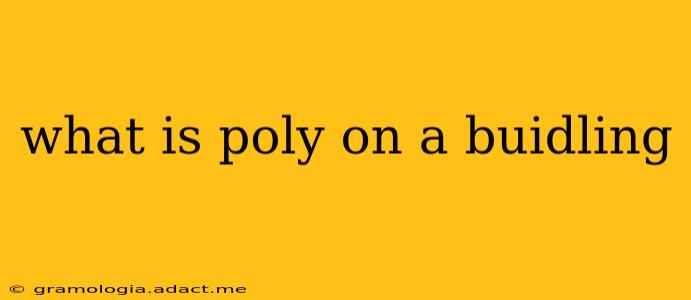The term "poly" on a building usually refers to polyurethane foam insulation (PUF). It's a versatile and increasingly popular material used in various construction applications for its exceptional thermal and acoustic properties. But what exactly is it, and why is it so prevalent in modern building practices? Let's delve into the details.
What is Polyurethane Foam Insulation?
Polyurethane foam is a synthetic material created through a chemical reaction between two liquids: a polyol and an isocyanate. This reaction results in a lightweight, rigid foam with a cellular structure filled with gas. This gas, often a blend of different compounds, contributes significantly to the foam's insulating properties. The foam itself can be sprayed, poured, or pre-fabricated into panels or boards.
Types of Polyurethane Foam Used in Building Construction
There are primarily two types of polyurethane foam used in construction:
-
Spray Polyurethane Foam (SPF): Applied directly to the building's structure, this type offers excellent air sealing and conforms perfectly to irregular surfaces. It is often used for both insulation and air barrier applications.
-
Rigid Polyurethane Foam Boards: These pre-fabricated panels are easy to install and provide a consistent level of insulation. They are commonly used for exterior wall insulation, roof insulation, and even foundation insulation.
Why is Polyurethane Foam Used in Buildings?
Polyurethane foam boasts several advantages that make it a desirable choice for building insulation:
-
High R-Value: This indicates excellent thermal resistance, meaning it effectively reduces heat transfer, lowering energy bills and improving indoor comfort.
-
Superior Air Sealing: Its ability to create a continuous, airtight seal helps reduce drafts, moisture infiltration, and energy loss.
-
Lightweight: This characteristic simplifies installation and minimizes structural load.
-
Versatility: It can be used in various applications, from roofs and walls to foundations and attics.
-
Noise Reduction: Polyurethane foam also exhibits effective sound dampening capabilities, enhancing the building's acoustic insulation.
What are the Drawbacks of Using Polyurethane Foam?
While polyurethane foam offers many benefits, it's essential to be aware of some potential drawbacks:
-
Off-gassing: Some polyurethane foams can release volatile organic compounds (VOCs) during and after installation. However, low-VOC or zero-VOC options are increasingly available.
-
Flammability: While treated to be flame-retardant, polyurethane foam is still combustible. Proper fire safety measures are crucial.
-
Cost: Depending on the type and application, polyurethane foam can be more expensive than other insulation materials.
-
Installation Expertise: Proper installation is critical for optimal performance. Improper application can compromise the insulating properties and even create health and safety issues.
Is Polyurethane Foam Environmentally Friendly?
The environmental impact of polyurethane foam is a complex issue. While the production process involves some chemical compounds, advancements have led to the development of more sustainable and recycled content options. Additionally, its excellent insulating properties can contribute to reduced energy consumption and a smaller carbon footprint over the building's lifespan. Choosing low-VOC or recycled content options minimizes the environmental impact further.
What are the different types of polyurethane foam insulation?
This question is answered in detail above under "Types of Polyurethane Foam Used in Building Construction". Different types cater to varying installation needs and provide distinct advantages in specific applications.
Is polyurethane foam insulation safe?
Polyurethane foam insulation is generally considered safe when installed and used correctly by qualified professionals. However, concerns exist regarding potential off-gassing of VOCs. Selecting low-VOC or zero-VOC options significantly mitigates these risks. Furthermore, proper ventilation during and after installation is crucial to ensure indoor air quality.
How long does polyurethane foam insulation last?
The lifespan of polyurethane foam insulation varies based on the application, environmental factors, and the quality of installation. However, it's generally expected to last for several decades, contributing to a building's long-term energy efficiency and comfort.
In conclusion, "poly" on a building signifies the use of polyurethane foam insulation, a high-performance material that offers significant benefits for thermal efficiency, air sealing, and sound dampening. Understanding its properties, advantages, and limitations is essential for both builders and homeowners seeking to improve their building’s performance and energy efficiency.
